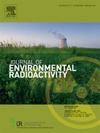福岛森林和下游地区淡水鱼体内137Cs积累的环境和生物驱动因素
IF 2.1
3区 环境科学与生态学
Q3 ENVIRONMENTAL SCIENCES
引用次数: 0
摘要
为了阐明控制淡水鱼体内137Cs积累的生态因素,我们研究了在2020年至2022年期间从福岛疏散区的森林源溪流和河流下游采集的10种鱼类。通过将土地覆盖数据与同位素和体型指标相结合,我们的研究阐明了事故后环境中鱼类群落中放射性元素分布的形成机制。在所有地点均发现个体超过日本规定的100 Bq/kg-wet,并且137Cs的鱼/水浓度比差异很大,从海马苏鲑鱼的9.7 × 10 L/kg-wet到日本鲮鱼的1.2 × 106 L/kg-wet。白斑鲑和马苏鲑都是典型的溪栖鲑科,其浓度比显著高于其他种类。来自森林覆盖面积较大地区的鱼类显示出持续升高的137Cs浓度,这表明在事故发生十多年后,森林是水生食物网中放射性铯的持续来源。稳定同位素分析表明,陆源碳贡献与137Cs浓度之间存在显著的正相关关系,表明吸收陆源资源越多的个体积累的污染物越多。相对体型与137Cs浓度之间也存在正相关关系,表明生长相关性状影响其积累。这些结果表明,森林连通性、对外来资源的饮食依赖以及个体生长特征共同影响了淡水鱼体内137Cs的积累。该方法和研究结果为森林河网中放射性元素长期动态的物种和地点特定过程提供了定量证据,为辐射影响景观的风险评估和渔业管理提供了信息。本文章由计算机程序翻译,如有差异,请以英文原文为准。

Environmental and biological drivers of 137Cs accumulation in freshwater fish across forested and downstream sites in Fukushima
To elucidate ecological factors governing 137Cs accumulation in freshwater fish, we examined 10 species collected from forested headwater streams and downstream reaches of rivers flowing through the Fukushima evacuation zone between 2020 and 2022. By integrating land cover data with isotopic and body size metrics, our study clarifies mechanisms shaping radiocesium distribution across fish communities in post-accident environments. Individuals exceeding the Japanese regulatory limit of 100 Bq/kg-wet were found at all sites, and fish/water concentration ratios of 137Cs varied widely, from 9.7 10 L/kg-wet in a sea-run masu salmon to 1.2 106 L/kg-wet in a Japanese dace. White-spotted charr and masu salmon, both typical stream-dwelling salmonids, exhibited significantly higher concentration ratios than the other species. Fish from areas with greater forest cover exhibited consistently elevated 137Cs concentrations, indicating that forests serve as persistent sources of radiocesium to aquatic food webs more than a decade after the accident. Stable isotope analysis showed a significant positive association between terrestrial carbon contribution and 137Cs concentration, demonstrating that individuals assimilating more terrestrial-derived resources tended to accumulate higher contamination. A positive relationship was also observed between relative body size and 137Cs concentration, suggesting that growth-related traits influence accumulation. These results suggest that forest connectivity, dietary reliance on allochthonous resources, and individual growth characteristics collectively influence the accumulation of 137Cs in freshwater fish. The approach and findings provide quantitative evidence for species- and site-specific processes underlying long-term radiocesium dynamics in forested river networks, informing risk assessment and fisheries management in radiologically impacted landscapes.
求助全文
通过发布文献求助,成功后即可免费获取论文全文。
去求助
来源期刊

Journal of environmental radioactivity
环境科学-环境科学
CiteScore
4.70
自引率
13.00%
发文量
209
审稿时长
73 days
期刊介绍:
The Journal of Environmental Radioactivity provides a coherent international forum for publication of original research or review papers on any aspect of the occurrence of radioactivity in natural systems.
Relevant subject areas range from applications of environmental radionuclides as mechanistic or timescale tracers of natural processes to assessments of the radioecological or radiological effects of ambient radioactivity. Papers deal with naturally occurring nuclides or with those created and released by man through nuclear weapons manufacture and testing, energy production, fuel-cycle technology, etc. Reports on radioactivity in the oceans, sediments, rivers, lakes, groundwaters, soils, atmosphere and all divisions of the biosphere are welcomed, but these should not simply be of a monitoring nature unless the data are particularly innovative.
 求助内容:
求助内容: 应助结果提醒方式:
应助结果提醒方式:


